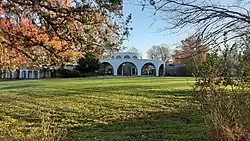| Sheppard Pratt at Ellicott City | |
|---|---|
 The New Center of Taylor Manor (c. 1968) | |
 | |
| Geography | |
| Location | 4080 College Ave, Ellicott City, Maryland, United States |
| Coordinates | 39°15′23″N 76°47′35″W / 39.256250°N 76.793028°W |
| Organization | |
| Type | Psychiatric hospital |
| Affiliated university | Sheppard Pratt |
| Services | |
| Beds | 50 |
| Links | |
| Website | http://www.sheppardpratt.org/ |
| Lists | Hospitals in Maryland |
Sheppard Pratt at Ellicott City[1] was a private psychiatric hospital located in Ellicott City, Maryland. It had a 20-bed adult unit, an 18-bed co-occurring disorders unit, an 18-bed crisis stabilization unit, a 22-bed adolescent unit, and an adult day hospital. The hospital was owned and operated by the Towson, Maryland based Sheppard Pratt Health System
Prior to its purchase by Sheppard Pratt the facility was known as Taylor Manor, one of only a dozen privately owned psychiatric facilities in the nation. [2] The hospital closed with the opening of Sheppard Pratt at Elkridge in 2020.[3] Most of the original structures were already demolished prior to the campus closure, as new plans for the Taylor Highlands development were already underway.[4]
History
In 1907 Taylor Manor started as the Howard County Sanitarium Company built on property along College Avenue and New Cut Road in Ellicott City owned by Dr. Rushmore White.[6] The twenty person facility suffered a fire in 1923.[7] In 1939 the facility was purchased by Issac H. Taylor and renamed Patapsco Manor and later renamed as the Pinel Clinic (after the French psychiatrist who took the chains off the patients in asylums outside Paris). Taylor operated an optometrist business and Taylor's Furniture on Main Street. In 1948 the facility expanded to 48 beds, and in 1968 it expanded to 151 beds.[8] The modern architecture circular rotunda stands out at the center of campus. Operated by Dr. Irving J. Taylor (1919-2014), and later Dr. Bruce T. Taylor in 1979, who served as medical director and chief executive officer, Taylor Manor covered more than 65 acres (26 ha) in Ellicott City Maryland. The Ayrd library is named after Taylor Manor Hospital Psychiatric Award winner Frank J. Ayd, MD.[9][10] In 1953 Dr. Irving Taylor and Taylor Manor Hospital was the first hospital in the country to offer the first psychiatric specific medication, an anti-psychotic medication, Thorazine (chlorpromazine). Other treatments firsts in the area included offering many of the antidepressant and antianxiety drugs as they were developed in the mid-1950s, a dual diagnosis program for treatment of addictions and psychiatric illnesses, a compulsive gambling treatment program, the first specialized treatment programs for adolescents and later for young adults, as well a unique crisis and respite program for adolescents.
The area next to the campus property has been expanded and subdivided by the Taylor family as Taylor Village where sections were sold for housing. The campus acreage totaled 55 acres (22 ha) in 2000.[11] By 2000, Taylor Manor had an operating loss of $1.1 million a year on $15.8 million in revenues. In 2001 Taylor manor's programs were absorbed into the 1500 employee Sheppard Pratt system.[12]
Taylor Manor Hospital provided buildings on campus for several community and mental health services, including: Halfway Home group home from 2003-2018 for addictions, Our House for young men, Maryland Alternative Care for children, and in 2006 Grassroots crisis intervention center operated a 33-bed homeless shelter on the campus while expanding their facilities at Atholton High School.[13]
 New Center
New Center Walkway of the New Center
Walkway of the New Center Archway and courtyard
Archway and courtyard Office Building
Office Building
"Firsts" at Taylor Manor
In 1966, Taylor Manor started the first psychiatric treatment program in Maryland for adolescents.[14] Dr. Irving Taylor collaborated with on-site research into the drug Thorazine becoming the first to use anti-psychotic medicine on patients.[15] In 1983 Robert L Custer took gambling research from Ohio to Taylor Manor to create a gambling addiction treatment center . He summarized that gambling addicts had a fear of dying and included a treatment plan that included repaying gambling debts.[16]
Significant events
| Date | Event |
|---|---|
| 1851 | Moses Sheppard founds the first Asylum funded by the State of Maryland. The Sheppard Asylum opens in 1891.[17] |
| 1907 | The 12 bed Patapsco Manor Sanirium is built. |
| 1939 | Patapsco Manor is purchased from Dr. Rushmore White and managed by Ellicott City shop owner Isaac H. Taylor.[18] The facility is renamed the Pinel Clinic. |
| 1941 | Pinel Clinic opens a disturbed ward building and occupational therapy shop. |
| 1948 | A Four story 24,000 sq ft facility is built on campus. Expanding capacity to 48 beds. |
| 1949 | Dr. Irving Taylor becomes medical director and his wife Edith Lee Goodman becomes executive director.[19] |
| 1954 | Hospital renamed Taylor Manor |
| 1968 | The New Center opens with 151 beds. |
| 1978 | Isaac H. Taylor dies |
| 1969 | Dr. Irving Taylor starts mental health symposiums continuing for over 25 years.[20] |
| 1982 | Changing Point Treatment Center opens |
| 1991 | Taylor manor opens an 8- to 22-month program for clergy members in need of support.[21] |
| 1997 | Behavioral Health Management Association (BHMA) petitions to run a 26-bed hospital for juvenile sex offenders.[22] |
| 2000 | Taylor Manor serves 1,544 inpatients and 4,522 outpatient visits.[23] |
| 2001 | Taylor Manor offers campus property to build a school in Ellicott City. |
| 2002 | Sheppard Pratt starts operations at Taylor Manor. |
Areas of concentration
Notable staff
Notable patients
See also
- The Sheppard and Enoch Pratt Hospital
- Chestnut Lodge Rockville Maryland.
References
- ↑ "Sheppard Pratt". Retrieved 25 August 2013.
- ↑ "Sheppard Pratt". Retrieved 25 August 2013.
- ↑ "Sheppard Pratt Health System Holds Groundbreaking for New Hospital Campus".
- ↑ https://data.howardcountymd.gov/scannedpdf/Historic_Sites/HO-975.pdf
- ↑ "Crested View at Taylor Highland Design Advisory Panel Presentation". Archived from the original on 2020-10-17. Retrieved 2020-11-10.
- ↑ Janet Kusterer, Victoria Goeller. Ellicott City. p. 47.
- ↑ "PATIENTS ARE SAVED FROM HOSPITAL FIRE: Skidding Apparatus, Answering Ellicott City Alarm, Injures 4 Boys". The Washington Post. 22 November 1923.
- ↑ Janet Kusterer, Victoria Goeller. Ellicott City. p. 47.
- ↑ Jamie Smith Hopkins (12 February 2001). "Taylor, county in land talks Two sides discussing property options for elementary school". The Baltimore Sun.
- ↑ Frank J. Ayd (1995). Lexicon of Psychiatry, Neurology, and the Neurosciences. ISBN 9780683002980.
- ↑ Jamie Smith Hopkins (12 February 2001). "Taylor, county in land talks Two sides discussing property options for elementary school". The Baltimore Sun.
- ↑ Sabrina Jones (27 June 2002). "End of a Hospital's Family Era; Psychiatric Facility To Change Hands". The Washington Post.
- ↑ Larry Carson (22 September 2006). "Crisis center moving, for now Grassroots is going to Ellicott City while new facility is built". The Baltimore Sun.
- ↑ Margret Right Wise. Ellicott City. p. 125.
- ↑ "Light Shines on Howard hospital". The Baltimore Sun. 31 August 1997.
- ↑ Howard Padwa, Jacob Cunningham. Addiction: A Reference Encyclopedia. p. 116.
- ↑ "Sheppard Pratt History". Retrieved 26 August 2013.
- ↑ "Light Shines on Howard hospital". The Baltimore Sun. 31 August 1997.
- ↑ Frederick N. Rasmussen (19 November 2014). "Dr. Irving J. Taylor, psychiatrist". The Baltimore Sun.
- ↑ Sherry Joe (22 April 1994). "Taylor Manor holding 25th symposium today". The Baltimore Sun.
- ↑ "PROGRAM ADDRESSES RELIGIOUS NEEDs". Post Tribune. 23 November 1991.
- ↑ Dana Hedgpeth (19 August 1997). "Juvenile sex offender hospital opposed Ellicott City residents launch petition against Taylor Manor proposal". The Baltimore Sun.
- ↑ Sabrina Jones (27 June 2002). "End of a Hospital's Family Era; Psychiatric Facility To Change Hands". The Washington Post.
- ↑ Frank J. Ayd (1995). Lexicon of Psychiatry, Neurology, and the Neurosciences. ISBN 9780683002980.
- ↑ S. Nassir Ghaemi. Polypharmacy in Psychiatry.
- ↑ David Herzberg. Happy Pills in America: From Miltown to Prozac. p. 21.
- ↑ Jack Mann (16 February 1986). "Franklin Comes Back Again". Chicago Sun Times.
Further reading
- Affective Disorders Reassessed—1983 Frank J. Ayd, Irving J. Taylor, Bruce T. Taylor (M.D.)